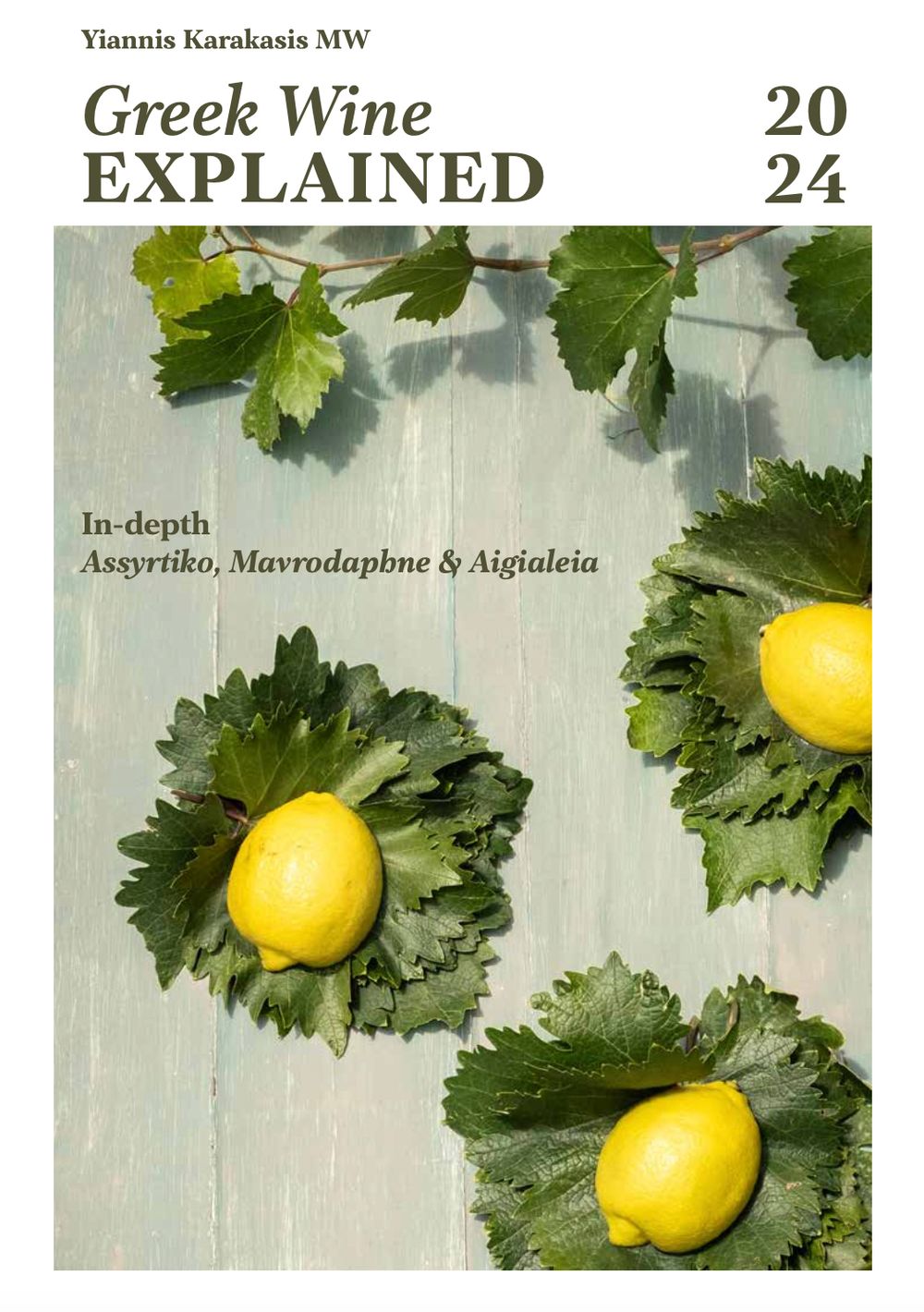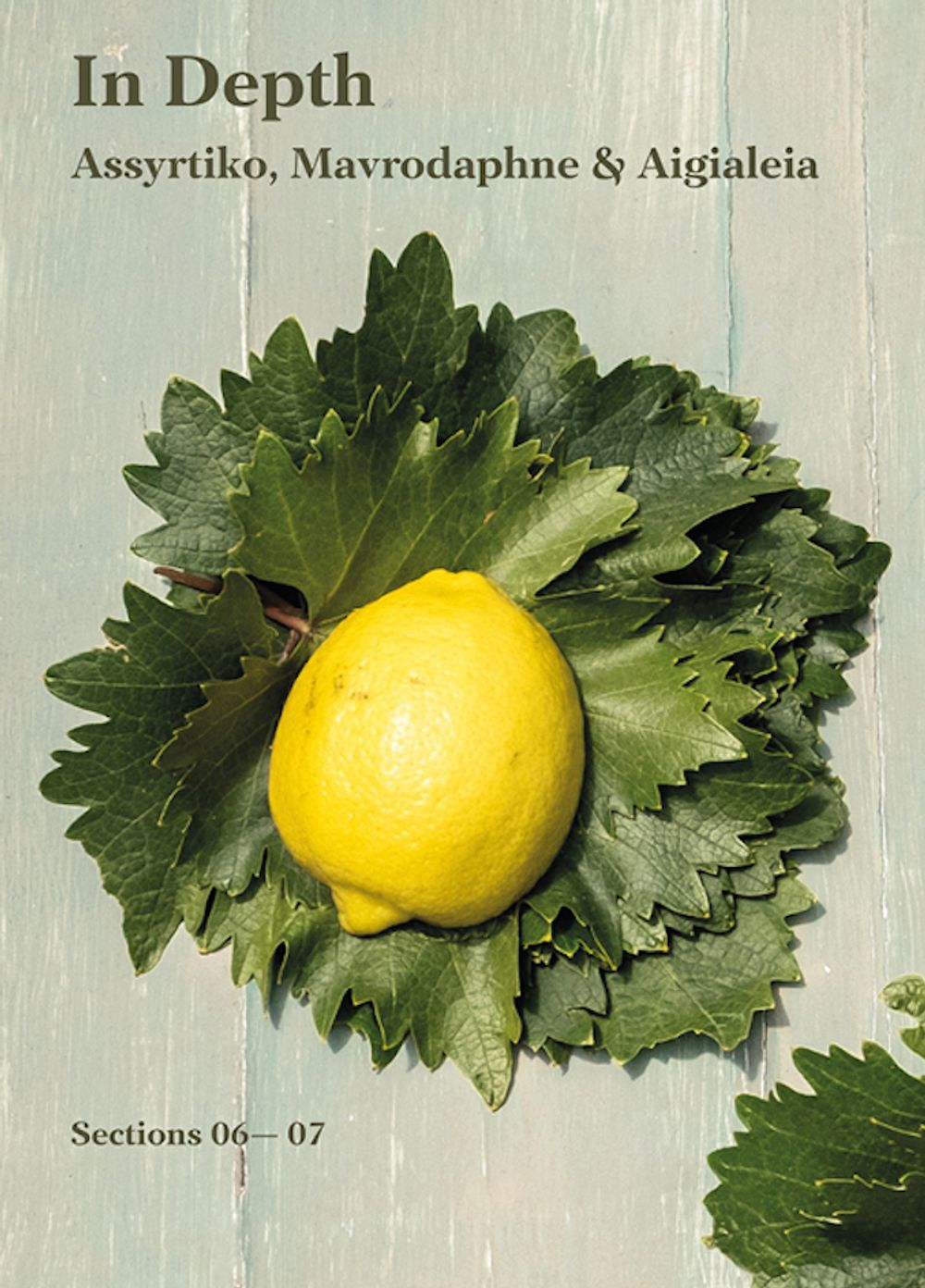Greek Wine Explained has been produced with the support and help of Greek wine writer, Evmorfia Kostaki, who also shares her insights on the potential of Greek wines. All answers below are byYiannis Karakasis MW unless stated.
Can you tell us about Greek Wine Explained and what you are hoping to achieve with this new report?
Greek Wine Explained is an annual 25,000 word online wine guide over 116 pages. It aims to provide comprehensive information about the current position of Greek wine on the global stage, along with numerous wineries and wine recommendations. The report is divided into two sections.

The ambitious comprehensive Greek Wine Explained report from Yiannis Karakasis MW
Greek Wine Explained covers news and developments in the Greek wine industry over the past year and focuses on the challenges faced by old vineyards and reviews the 2023 vintage. It includes an interview with Nikos Karatzas, one of the most talented Greek winemakers and provides lists of new and emerging wineries, along with value-for-money proposals and wines not to be missed.
The In-Depth section analyses the indigenous Greek varieties Assyrtiko, Mavrodaphne, and the Aigialeia wine region. These topics will change each year. The final chapter includes information on all Greek grape varieties, as listed in the national catalogue, and will be enriched over time.
Greek wine has come a long way over the past years. I believe that in today’s rapidly evolving global wine scene, an annually updated Greek wine report has become indispensable. With surging numbers of wineries, a plethora of new efforts being made and tremendous interest from international markets, the Greek wine industry is experiencing unprecedented growth and innovation. As the Greek wine landscape flourishes, staying informed and updated on the latest developments, trends, and achievements becomes crucial for industry professionals and wine enthusiasts.
How did the project come about, and how did you go about compiling the report?

Mark Andrew of Noble Rot, top right, was one the judges of the recent 50 Great Greek Wines organised by Yiannis Karakasis MW
I’ve been mulling over this project for the past three years, and after the success of my book “The Wines of Santorini,” the timing felt just suitable for something fresh to take form. In conversations with my good friend Noble Rot’s Mark Andrew, who is a fanatic supporter of Greek wine, he suggested a structure comprising two parts: one to cover news, wineries, and vintages, and another to delve deeper into the subject. The rest came into shape with many hours of creative thinking with Evmorfia Kostaki, who is a brilliant wine person.
Who do you hope the report will be most useful for?
Everyone. Such a report serves as a vital tool for consumers, sommeliers, educators and investors alike, enabling them to make informed decisions, appreciate the richness of Greek wines, and contribute to this flourishing industry’s continued success and recognition on the global stage.
Why have you focused specifically on the varieties of Assyrtiko and Mavrodaphne and the Aigialeia region?

The new report shines the light on Greek’s key indigenous varieties and emerging regions
There are no limitations here. The idea was simple. Assyrtiko is the point of reference for Greek wine, so I needed to respect that, and Mavrodaphne as a variety is emerging with a new identity. I find this fascinating, so it was a yes, let’s do it.
If there is one terroir that is still unsung but also very contemporary, it is the highlands of Aigialeia, home of old Roditis vinesin the Peloponnese. Next year, it may be Xinomavro, orange wines and Tinos or Crete, Agiorgitiko and Retsina. We have not decided yet.
How do you see Greece’s position in the world now as a wine country in terms of the quality and diversity of wines it can offer?
Greek wine has never been as intriguing and captivating as it is today. However, it still remains somewhat in the shadows, except for the well-known Assyrtiko, Malagousia, and possibly Xinomavro. I am eager to capture and unravel this momentum and share untold stories that are waiting to be discovered.
The diversity is truly exhilarating, from the innovative Liatiko approach in Crete to the fresh interpretations of Xinomavro in Macedonia. From the vibrant dry Mavrodaphnes in Cephalonia and the Peloponnese to the exciting wines of the Aegean Islands, there is an abundance of discovery. Everywhere I venture, I uncover new things and new narratives to share.
What do you think the overall perception of Greek wine is in international markets and what do you think the country and its producers should focus on to change that?

Evmorfia Kostai is assistant editor of Greek Wine Explained
Evmorfia Kostaki: Historically, Greek wine exports have been dominated by large producers or bottlers focusing on moving high volumes rather than taking pride in quality offerings. Since the 2010s, many quality Greek producers have fought so their wines could achieve a premium spot in high-end retailers and restaurants. This was partially because Greek wine was more mature by then and partially because the producers were forced to look for new markets due to the Greek financial crisis.
Little by little, I believe the perception of cutting-edge professionals has changed, first by accepting the presence of Greek wines and then by supporting them. However, the reality is the general consumer sees Greek wine as lower quality wines, either found in taverns run by Greek immigrants or stored at the dark, dusty corners of large wine shops.
Greek wine is still enjoying a phase of exploration. Besides a few benchmark varieties and regions, much of it is undiscovered. I believe what is needed both by the producers, the government and private initiatives, like this report, is to educate the curious members of the wine trade, as well as consumers, on what Greek wine has to offer and help them make purchase decisions that will not disappoint them.
Unfortunately, Greek wine of questionable quality is still produced. The biggest challenge is to offer great wines that will spark conversation and lead to individuals who will be willing to take another sip of Greek wine. Then, a whole new wine universe will be ready for discovery.
What do you think are the big growth opportunities for Greek wines in terms of styles, varieties?
In addition to the already successful Assyrtiko and Malagousia, I believe there’s a golden opportunity for Agiorgitiko to flourish, given a focused strategy. Furthermore, there’s ample room for upcoming varieties like Limniona, Mavrodaphne, and Liatiko to make their mark. Moschofilero is experiencing a resurgence, with numerous new producers entering the scene. Regarding styles, the compass points towards either new-wave Retsinas or skin-contact wines.
What are the big challenges/ obstacles that the country and its producers need to over come?

The report features key Greek winemakers like Nikos Karatzas
Evmorfia Kostaki: The obvious answer would be that the different language and alphabet are some of the biggest issues. However, I believe communication difficulties can be overcome, especially since younger, more educated professionals take over Greek wine. As a producer myself, the biggest challenge is the rigid government rules wine has to follow and the lack of a long-term government plan for Greek wine to allow for stability in the sector.
Producers in Greece have learned to navigate the system, yet they can not always reach their full potential because of its limitations. One example is that the official list of Greek varieties published in 2022 omits varieties allowed in some PGIs, which will naturally lead to implications regarding labelling and future plantings.
Is this the first of this kind of report you have done and do you hope to do more in the future to update the report?
Actually, this is the second; I did one for the 2017 vintage, but GWE 2024 is more complete and has the structure I was searching for. The plan is to release it every year.
Why did you work on the report together?
This project turned out to be much bigger than we initially anticipated, surpassing our expectations of around 15,000 words. It’s evolved into more of a book than a mere report. As such, it requires substantial support to ensure its continuation annually.
- To get a copy of Greek Wine Explained click here. It costs €20.









































